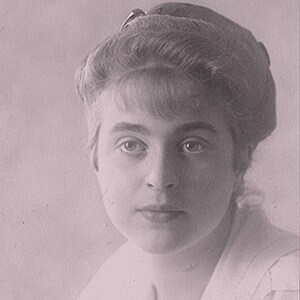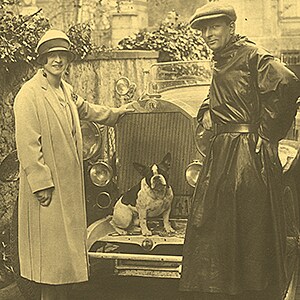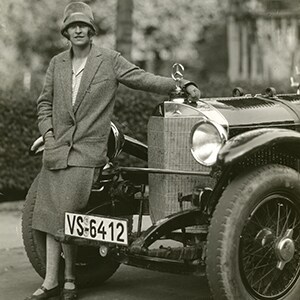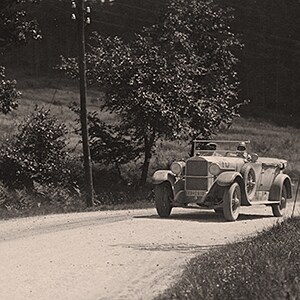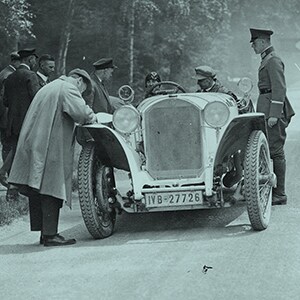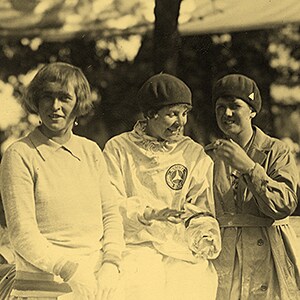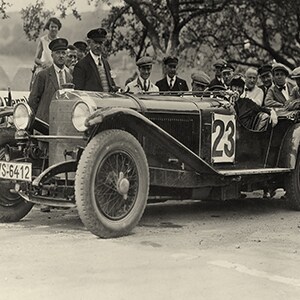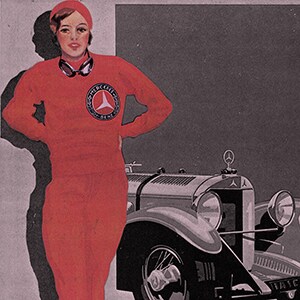
»The woman behind the wheel of the car is particularly fascinating.«
Darmstädter Tagblatt, September 5, 1926
In the 1920s, Ernesta »Ernes« Merck, née Rogalla von Bieberstein, is one of the most successful and well-known female racing drivers in Germany. In just a few years she goes from being a young woman of high society to the archetype of the New Woman: knee-length dresses, sporting attire or trousers and a sweater; with a bobbed hairstyle under a modern cloche hat, Ernes sits in her car smoking a cigarette.
In October 1918, twenty-year-old Ernes marries Wilhelm Merck, who is five years her senior. Technology enthusiast Wilhelm has been active on the racing scene for years and teaches his young wife to drive, as well as the basics of automotive engineering. She soon shares his passion. In November 1921, Ernes takes her driving test. Apart from knowledge of the traffic rules, she must also demonstrate her technical skills. But it is the field of motor engineering, at the time rather unusual for women, which sparks her enthusiasm.
Her career as a racing driver starts in July 1922 in Baden-Baden, where she competes in a Steiger car and takes second place. This is followed by numerous wins and prizes, mostly in Mercedes or Benz cars. Within five years, Ernes becomes one of the best and most successful racing drivers in Germany. Especially in the discipline alpine and touring car racing, she celebrates a string of successes. The highpoint of her career is without doubt the race on the Klausen Pass in August 1927. On this day, only Rudolf Caracciola – the best and most famous German racing driver of this time – is faster than she.
The daily newspapers, as well as automotive and women’s magazines, feature numerous articles about Ernes Merck, Germany’s top female racing driver. After all, people are fascinated by this pretty young woman who throws herself into such adventures and dangers and emerges both unscathed and successful.
In 1928, Daimler AG issues a new advertisement. The poster shows a young woman leaning nonchalantly against the wall of a house. She is wearing a red racing suit with the Mercedes-Benz emblem and racing driver goggles around her neck. A partially concealed Mercedes-Benz S type is in the background. Referred to as the »Lady in Red«, this poster becomes one of the most iconic advertisements of the Stuttgart-based car manufacturer. With this advertisement, Daimler creates a monument to one of the greatest female racing drivers, since Ernes Merck was the »Lady in Red«. She herself does not live to see this tribute. In November 1927, at the highpoint of her career, Ernes takes her own life.
From »high-society daughter« to the »New Woman«: In 1921, a girl wearing long skirts, white blouses and her hair pinned up smiles in the family photographs. Just a few years later, this girl has become a successful and modern young woman.
In 1926, the newspaper »Darmstädter Tagblatt« writes, »What particularly predestined Mrs. Merck to reach the, for a woman, quite extraordinary success in the area of motor racing is […] her admirable energy and, for a woman, remarkable skill in handling a car.«
Within five years, Ernes Merck becomes one of the best and most successful racing drivers in Germany. Especially in the discipline alpine and touring car racing, she celebrates a string of victories. Between 1922 and 1927, she competes in more than 16 races in which she demonstrates her skills and daring.

